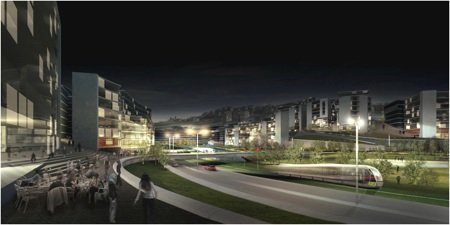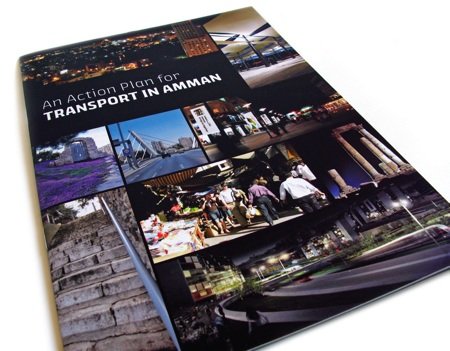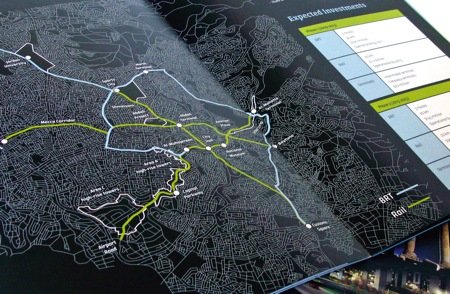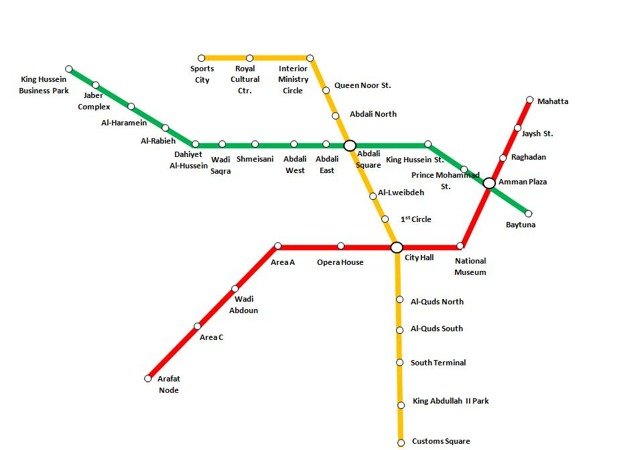
Will we be riding a modern metro and bus system that takes us across Amman with comfort and ease? Any serious discussion about Amman and its problems is bound to hit upon the issue of transport. Wether we’re complaining about the increasing occurrence of traffic jams, how Amman has turned into a car city, how we have lost some precious pedestrian areas, the tragedy of traffic accidents, social inequality and the city’s identity.. transport has something to do with it.
Public transportation can be singled out as Amman’s biggest failing over the past decades.
In some old photos of Amman, you can see busses, marked with numbers, rolling through downtown Amman. Could it be that, at one point, the level of public transport in Amman was actually on par with the city’s development?
Probably yes.
But at one point, things started going wrong. We got rich quick on oil money from the Gulf (in the mid 1970 onward). We all wanted bigger houses, preferably far out of town and, with that, bigger and more cars. Public transport fell of the public agenda and so the public transport system simply did not keep pace with the city’s growth and development.
Solving the transport problem in Amman became a matter of building bridges and underpasses that cost millions of Dinars and only invited more traffic onto the streets. Public transport was ignored in favor of coming up with “traffic solutions”.
Today, we are a car city. We don’t walk and we definitely prefer not to take the bus. That’s not to say that there aren’t hundreds of thousands of bus users in the city who simply HAVE to take the bus. But everyone wishes for a private car. I even once heard a radio commercial for a car brand that mocked the practice of riding the bus!
Our public transport system in Amman is very inferior, considering the city’s size, wealth and level of human development.
In short, what is needed is a public transport revolution in Amman.
What many people don’t know is that the beginning of such a revolution has already taken place inside the Greater Amman Municipality. My work with GAM over the past year on branding the city, has given me a perspective on what is happening. I also found out that even people who have an interest in urban and city planning issues do not know that new thinking on public transport is taking root inside Amman’s Municipality.
So what is happening?

Well, first there is the issue of official awareness. GAM has taken over the responsibility of public transport in Amman, which used to be handled by the Public Transport Regulatory Commission. I have heard Mayor Omar Maani decalre, more than once, that public transport is at the top of GAM’s priorities. What’s also important that the vision for public transport at the level of the top leadership at GAM is one that is inclusive. It is very dangerous when public transport is viewed as a service for the “less fortunate” only. A capital city like Amman needs a high quality system that attract poor and rich and middle class citizen, old and young, men and women, able bodied and physically challenged people.
Public transport should neither be seen as “cost” of a “charity” program, neither as a “profit center” to make money from. Affordable and well functioning city transport services should be there to create economic opportunity (people should not pay half their salary just to get to work), give people a sense of social equity (families without cars should not be treated like second class citizens) and to give the city a sense of real “citiness” (a city is not a collection of villas and apartment blocks and cars, but a rich space for social interaction).
That level of understanding is there at GAM
Then there is the issue of leadership. That too has witnessed a change in Amman. Today, Ammanis need to know that there is a qualified Jordanian team responsible for planning and improving Public Transport in Amman. That team is headed by Dr Ayman Smadi, (view this presentation by Dr Smadi on the transport challenges and solutions for Amman) who has spent the past two decades doing research and development work on transport systems and traffic in the US. His team also comprises young, qualified Jordanians who specialize in the field.
So what is this team up to?

First of all, there is the so called Bus Rapid Transit system (BRT), which means that certain main streets in Amman will get a dedicated, closed-off bus lane (for example University/Queen Rania Street) where special large busses will operate between modern, specially designed stations. It is like having a train system without having to lay tracks.
This BRT system is now being designed with the help of a specialized global company, Steer Davies Gleave which has recently been awarded a contract to do that.
To better understand what a BRT system is, here is a very helpful blog post and video from Nasimjo, who wrote about the Istanbul BRT last year.

The BRT will form the backbone of Amman’s transport system of the future. Of course it will also include regular bus services, but hopefully with better busses running with regular schedules, stopping at proper bus stops (which will be installed city wide).
But the more exciting prospect for Amman’s transportation future is the introduction of rail, either in the form of a metro system or or a so-called light rail system. It is exciting to see the very early incarnations of a a proposed map for this system with three lines. Due to the hilly nature of Amman, this system will sometimes run overground and sometimes underground. It is a very expensive endeavor but probably a necessary one. The cost of not having a good transport system of Amman is also immense (fuel costs, road costs, environmental pollution, lost time in traffic jams).
The studies for this rail project are under way already.
So what does this add up to? First of all, the public transport revolution in Amman will not happen overnight. A city like Dubai built a super modern metro system in 3 years. But the Ammani plans are more of a 10 year endeavor, with some elements appearing within the coming few years.
The scary part of all of this exciting stuff that all the proposed systems end up being delayed (like the Amman Zarqa rail line that I’ve been hearing about since I was a teenager!). We just have too many example of ambitious, progressive projects in Jordan that end up being shelved for a million reasons.
A lot of responsibility falls onto GAM. Is there enough political will at the level of the city leadership and indeed at the level of the country’s leadership to bring about this revolutionary shift, that moves Amman (and also other Jordanian cities) from a congested car city to more manageable, European style, city of public mobility?
But there is a role for Ammanis as well, especially the Ammani “elite”. Honestly, what is needed is a paradigm shift in people’s minds. A whole Ammani movement needs to embrace GAM’s transport vision. Citizens from all walk of life need to support it. People with social and political influence need to believe in it.
Those who are using whatever public transport facilities we have in Amman would naturally welcome the improvement of such services. But it is the people with big cars in their garages who need to understand that Amman will never be a good city, clean city, safe city or a “cool” city without a modern transport system. People need to shake of their “it’s the government’s responsibility” mentality and start getting interested in what is happening beyond their private homes and gardens.
It is about regaining Amman’s public spirit, which might have been there at one point, but certainly got lost when too many people started treating the city as a bedroom and not as a place to come together, work together and celebrate together.
It is not a matter of supporting this or that particular project or a certain municipal leader. It is about getting interested in how the city functions and for once taking ownership of our urban environment.

Comments
15 responses to “Amman’s public transport development: will we seize the moment?”
I’m excited to hear about this, and thank you, Ahmad, for bringing it to our attention. I’ve been desiring to see Amman undertake such an endeavor since I moved to Jordan 4 years ago. The traffic congestion has become such a problem in the past several years, the city can’t afford NOT to make this happen!
the only way to persuade a Jordanian decision maker to consider such a massive undertaking is not by showing the project’s value to the average citizen but by showing him the great potential to steal lots of money. If you can do that, you will find dozens of advocates.
I came to the poit of not expecting anything from the people, especially from ourselves; some of the most indifferent, reckless and oblivious cultures of the world i’ve come across!
The public transportation system, no matter how glamorous or efficient will always be for the poor to some, the Umniah of getting around if you like! It doesn’t matter if public transportation system was better and more convenient than taking one’s car (the case in London for instance) people will still be stuck in rotten prescribed ideas about the absurd idea of riding a bus or a metro… though many haven’t had any hands on experience with the latter.
Our society is so in dire need for a zeros-flush format Humeid that even when the government take a progressive position of exempting hybrid vehicles from custom charges, what do we import? fracking 5 litter Escalades and Lexus SUVs! Instead of the Prius and Hybrid Civics…
Not to mention the sorry state of adoption of scooters as the most efficient, meaningful, wonderful, environmentally friendly and enjoyable way to get around town with.
I’m not saying that GAM should plan a public transportation system with the poor in mind, it should be as inclusive as possible by definition (being “public”). But not to expect or market or brand or position this ambitious long term project to cater for the culturally defeated quasi-well-off or elites of Amman.
Thus, GAM since it took the responsibility from the transportation commission, should focus the energy in keeping the project alive, translate it into a business proposition that will have a lucrative revenue-sharing model that will ensure continuity and consistency of quality service the user will come to expect from a revamped system.
so inspiring. I can’t wait to have public transport in Amman! I like Amman a lot, but the lack of buses drives me nuts!
If there is any way I can contribute to the project (join the team, or be a volunteer) I’d love to!!
Hey basem.. thanks for the thoughtful comment.
I have to agree with you on the general state of the “well off” and “elite”.
But, I think there is a chance to change attitudes, especially amongst the younger generation. Also remember that there is what one could call a middle class, who are not “poor” yet would benefit economically from public transport. They should be enlisted for the cause.
While my post above is an attempt to raise awareness on what’s happening in Amman, and stressing that such a project needs a wide social base, I think that state intervention is needed too.
Once there is good public transport, the government should make it more and more expensive for people to drive their cars into congested areas. We cannot expect people to change just out of the goodness of the hearts. Economic incentives are the strongest driver of change in the end.
Same goes for water consumption. Awareness campaigns are good and necessary. But I would advocate drastically raising water prices, especially for the rich.
Thanks for sharing! This is a very exciting and much needed development.
Thanks for posting this – it’s great to know what is being planned especially that we are usually left out of the planning process
I just have a comment/question: any particular reason the metro lines are being planned as ‘lines’ rather than the more efficient idea of ‘circles’ (like the London Tube for example)?. Because if I need to go everyay from Abdoun to Wadi Saqra, for example, I will need to go all the way to City Hall, and change twice, to do that. I like the idea of having all lines connect to City Hall for symbolic purposes…. but practically – the design can be more efficient still.
Ahmad,
As someone who is working on GAM’s transportation initiatives, I would like to thank you for a very well-written post. You have certainly touched upon many of the issues that make our job very challenging. What we’re working on really requires a change in the way of thinking–a paradigm shift–to something that is very different from the dominant ‘car culture’ we have in Amman today.
I would also like to point you and your readers to a Facebook group that we’ve recently created for the Amman Bus Rapid Transit (BRT) project. This is one of the first projects that will see the light, with some initial public works slated to begin as early as this October:
http://www.facebook.com/group.php?gid=137147761928
Thanks again for the post.
Fantastic! This is very good news.
Now if we could only get a royal commission for animal control of some kind…
Ahmad,
What kinds of jobs are available to smart American college grads in Jordan?
Thanks,
Diana
As a geographer with an interest in urban planning, I would love nothing more than to see those plans turn into reality, but I think that Amman is expanding too fast for proper managment let alone implement such project. I not saying that GAM did not introduce major project (transport ring road is one), but moving towards introducing busses and trains is a much harder task:
1. Buses and trains need designated lanes: we all know our street cannot accomodate cars let alone have a designated lane for buses and trains.
2. If GAM does decide to go ahead and designate lanes, roads would need to expand, so more traffic to come due to contruction and expansion of roads.
3. the basic infrastrucutre in Amman cannot acomodate this new change.
Personally, I would say that such project be implemnted in the new areas of amman. Even new areas of amman, have been hastily developed and in one way or another are chaotic ( the entire area behind Jordan Unviersity or areas on right and left hand side of the airport road.
Also the notion that small is beaufitul, smart and effective is something GAM often overlooks except in the case of the rainbow street. GAM should come to realize, or start, that big and huge is not always effective and in many cases does impact negativly on cities, New York is a good example where those huge highways that were sliced acorss the city brought in more traffic and just made downtown near unbearable. The same goes for the urban ring road GAM implemnted in Amman, again more traffic was divereted in Amman and entire area (Abdoun) was destroyed.
On the other hand, the rainbow street was a success, where smart and small urban planning and design for the first time in Jordan worked. I would say that using smart design is the key to solving many of Amman’s major urban problem for example;
1. Cancel the large to medium buses and use the smaller mini vans.
2. Reduce or remove those traffic marshals placed at every circle from the 1st the 8th since they do choke the city: Circles should not be manned by traffic marshals, it defeats the purpose.
3. Cut down on traffic lights: just focus on smart intersection, which are clearly market: have on lane for traffic that is going straight and designated lanes for turning left or right.
4. Need more public parking area: I am talk building like strucutre which can accomodate 200 or so cars. Ofcourse, there would be parking fees.
5. Have toll meters on highways for commuters: pay charge/congestion charge for entering Amman. Would encourage them to use public transport, again assuming there is a such a network to accomodate commuters.
Small things like make the difference, its not always about major highways, hanging bridges or fancy like presentation showing buses and trains and having designated lanes etc..
all in all, I do wish them good luck trying to manage the urban jungle we do live. At least its not as bad as cairo or other major cities.
cheers,
Faris D.
Great news, hope we see it happen, 10 years is really not long for such plans.
I agree with: “We cannot expect people to change just out of the goodness of the hearts.” make it harder for ppl to use the other mediums, cars for instance: more expensive to park, higher and actually enforced penalties, tolls, more fees if a household owns more than one car, more expensive car insurance, and even more of these conditions for ridiculously large “flashy” cars (that the Ammai’s and Arabs in general just love to have). at the same time, make an efficient, kind of cheap, “friendly”, working substitute (like busses and rail) and ppl will use them.
agree with Dina about steeling
agree with Deena about that circle lines could be more practical, Amman is spread out, definitely not like Dubai.
don’t agree with Faris D.
Keep on dreaming , It will never happen under this defunct government? you guys live in the fantasy world
And?
Same old “all talks, flashy brochures, and then projects put to sleep?
No money>
This isnt about rich, middle, poor class, this is about present day amman holding a population of only 2 million and the street are hell(traffic). All amman ever talks about is supporting “foreign investment” and bussiness in the country, you see this consists of employees (humans) that wake mostly in the morning like almost everyone else. Lets face it metros and light trains thats lah lah land, fast bus? not a bad idea and probably fits the budget, just wanna know how these busses are gonna fit in some of those roads, seriously i can barely fit (130 lbs), but hey thier trying pffft yeah, anyways good luck jordan….PLUS fine those crackhead that just cruise around for the fuck of it, im not saying i wasnt one of them though…